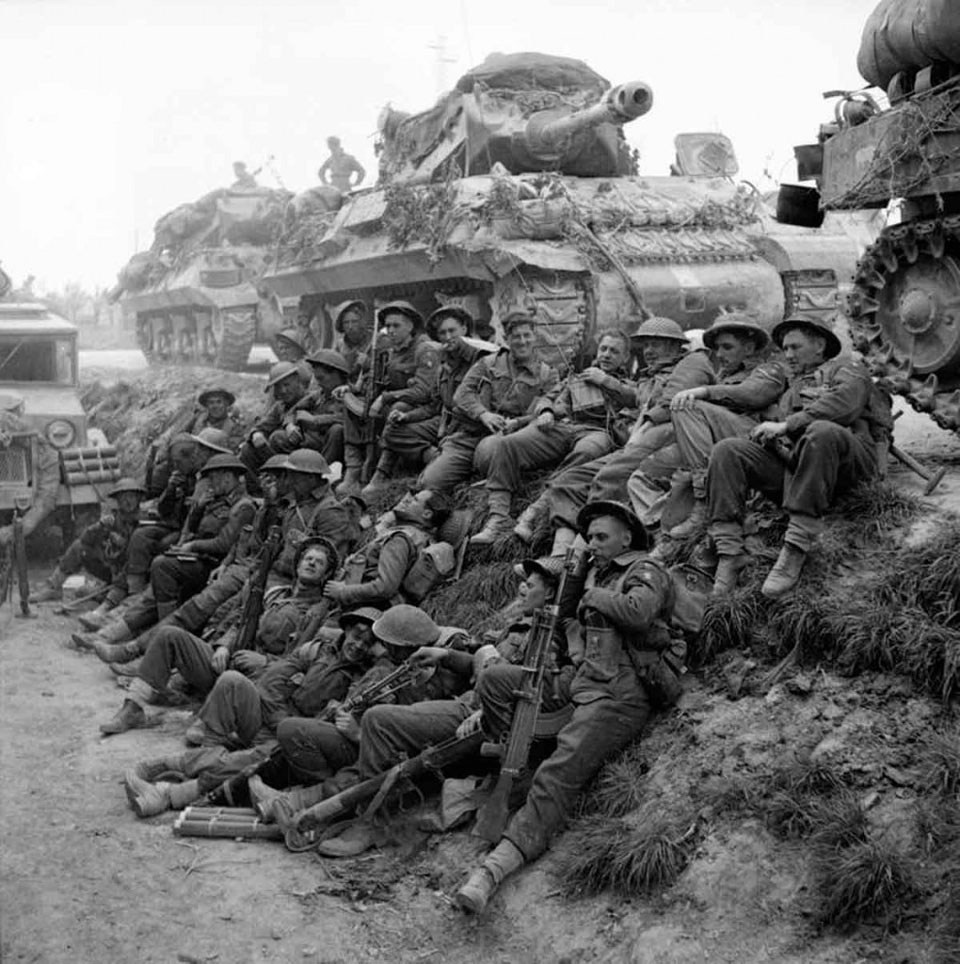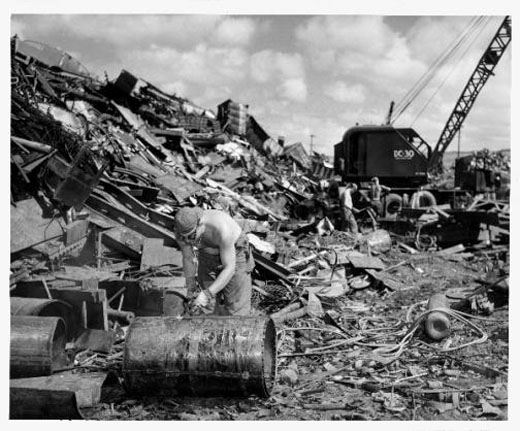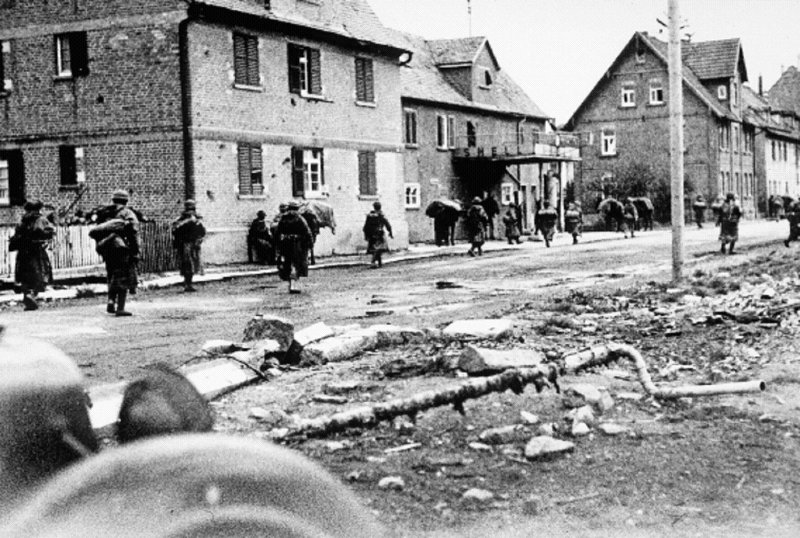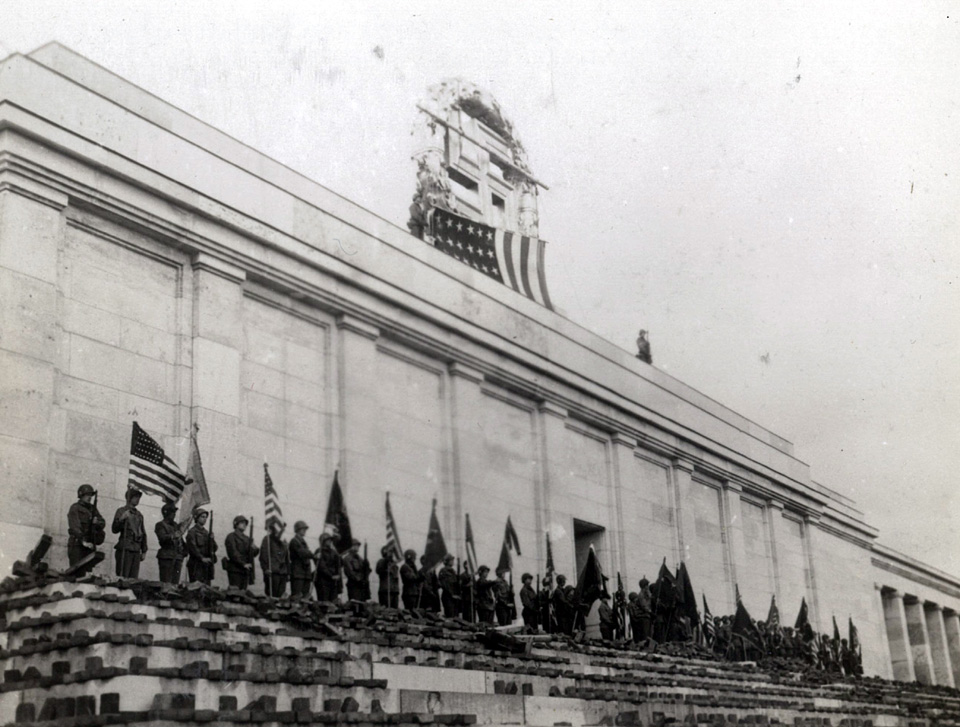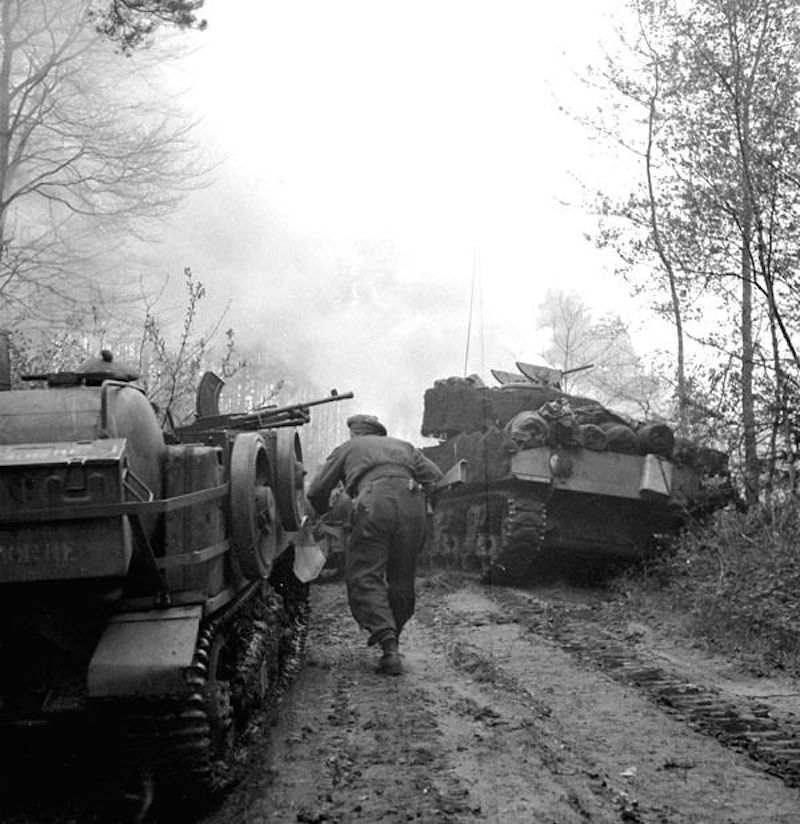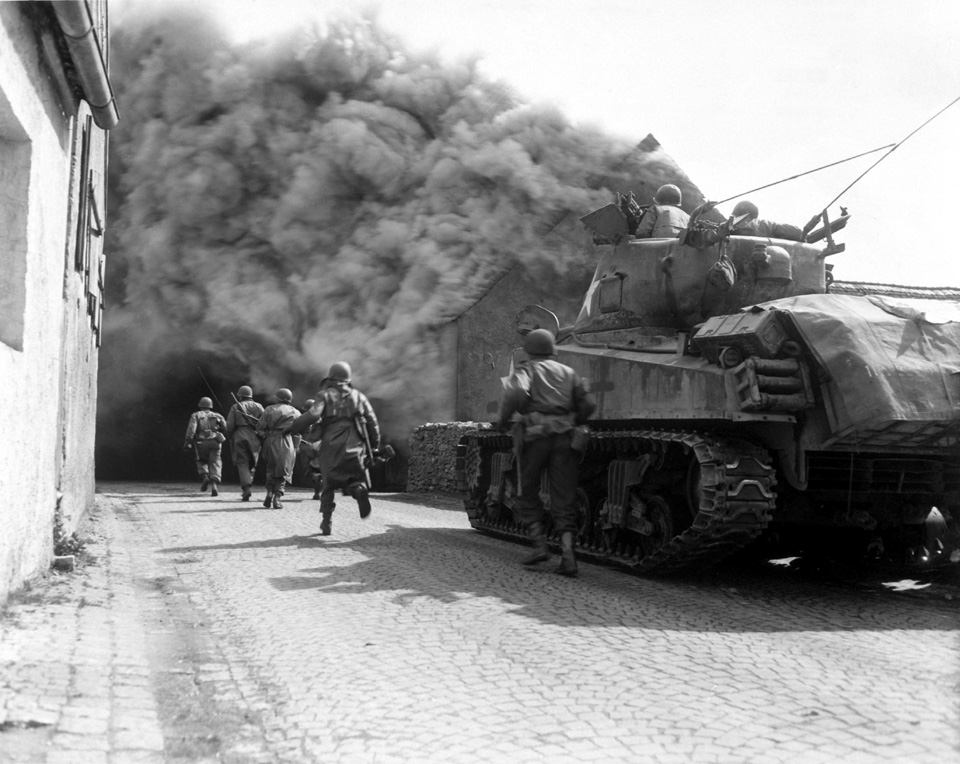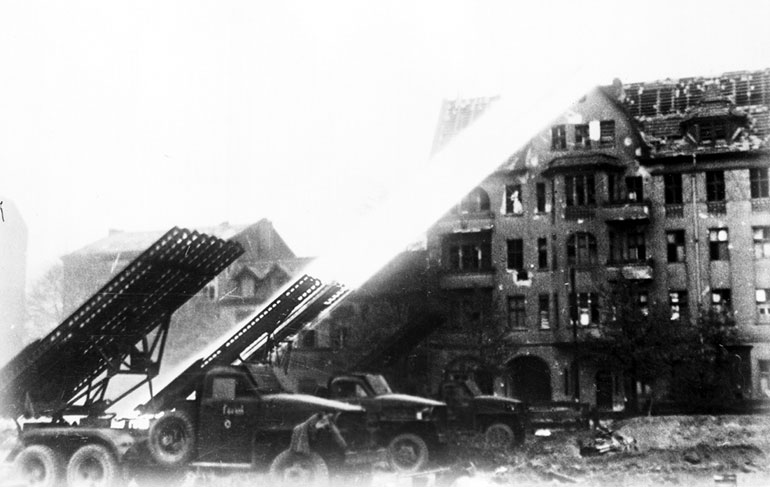Air Operations, CBI
CHINA- 2 308th Heavy Bomb Group B-24s attack Canton and Bakli Bay.
- 5 341st Medium Bomb Group B-25s attack Hsuchang and nearby targets.
- 19 14th Air Force fighter-bombers attack various targets.
- 20 380th Heavy Bomb Group B-24s attack shipping, port facilities and the naval base at Saigon.
Air Operations, East Indies
- XIII Bomber Command B-24s attack Jesselton and Manggar.
- 42nd Medium Bomb Group B-25s attack Tarakan.
- Fleet Air Wing 10 PVs attack various targets on Borneo.
- XIII Fighter Command P-38s attack Kuching.
Air Operations, Europe
RAF BOMBER COMMANDDaylight Ops:
- 767 aircraft including 651 Lancasters, 100 Halifaxes and 16 Mosquitos of Nos. 1, 3, 6 and 8 Groups are sent to bomb Bremen. This raid is part of the preparation for the attack by the British XXX Corps on Bremen. The bombing is on the southeastern suburbs of the city where the ground troops are scheduled to attack in 2 days. The raid is hampered by cloud and by smoke and dust from bombing as the raid progresses. The Master Bomber orders the raid to stop after 195 Lancasters have bombed. The whole of Nos. 1 and 4 Groups return home without attacking.
- 2 Lancasters are lost.
Minor Ops:
- 40 Mosquitos are sent to Bremen and 11 to Kiel, and there are 39 Mosquito patrols and 56 RCM sorties.
- There are no losses.
ITALY:
- The entire 12th Air Force is committed to slowing German Army forces retreating across the Po River.
- 12th Air Force B-25s mount 16 separate attacks on ferry lines and pontoon bridges.
- XXII TAC A-20s, A-26s, and P-47s mount around-the-clock attack on Po River crossings and troop movements throughout the Po River valley and on to the north. The XXII TAC claims the destruction of more than 900 motor and horse-drawn vehicles in a 24-hour period.
ITALY:
- 15th Air Force heavy bombers are grounded by bad weather, but 258 15th Air Force P-38s and P-51s attack airfields, road and rail traffic, marshalling yards, bridges, highways, and defended buildings throughout the day.
- During the night, XXII A-20s, A-26s, and night fighters attack Po River crossing points, airfields, road and rail traffic, marshalling yards and targets of opportunity.
Air Operations, Japan
- 87 XXI Bomber Command B-29s attack the Izumi airfield on Honshu, and the Kanoya, Kushira, Miyazaki, and Tomitaka airfields on Kyushu.
- 6 B-29s attack other targets.
- 99 VII Fighter Command P-51s attack the Akenogahara and Suzuko airfields on Honshu.
- 1 B-29 is lost.
- 15th and 21st Fighter group P-51s down 9 fighters over and near the 2 airfields on Honshu between 1215 and 1235 hours.
Air Operations, Philippines
5th and 13th air force bombers and fighter-bombers attack targets throughout Cebu, Luzon, and Negros. Following an attack by 33 1st Marine Aircraft Wing SBDs and 4 rocket-equipped VMB-611 PBJs against Japanese Navy infantry positions of Jolo Island’s Mount Daho, a US 8th Army ground attack carries the hill. Marine aircraft will continue to support the US Army troops on Jolo until the island is declared secure in the late summer.
[Air Operations, Ryukyus
- US Navy and Marine Corps aircraft support the US 10th Army on Okinawa.
- Task Unit 52.1.3 TBMs and F6Fs attack airfields in the Sakishima Islands.
- A VF-84 F4U downs a G4M 'Betty' bomber over Task Force 58 at 0030 hours.
- A VMF(N)-542 F6F a G4M 'Betty' bomber at sea at 0230 hours.
- A VF-84 F4U downs a C6N 'Myrt' reconnaissance plane over Task Force 58 at 1210 hours.
- A VF-9 F6F downs a C6N 'Myrt' reconnaissance plance at sea at 1400 hours.
- VF-12 F6Fs down 4 Ki-27 'Nate' fighters at sea between 1605 and 1610 hours.
- VBF-12 F6F pilots down a B6N 'Jill' torpedo bomber, a D3A 'Val' dive bomber, and 7 fighters near Kikai Shima at 1630 hours.
- VBF-9 F6Fs down 2 C6N 'Myrt' reconnaissance planes, a D4Y 'Judy' dive bomber, and a Ki-61 'Tony' fighter 80 miles from Task Force 58 at 1700 hours.
- VF-33 F6Fs down 7 Ki-43 'Oscar' fighters over Miyako Jima at 1720.
- VF-33 F6Fs down 2 Ki-43 'Oscar' fighters near Miyako Jima at 1820 hours.
- US Marine Corps F4Us down 5 D3A 'Val' dive bombers at sea at 1730 hours, and 28 D3A 'Vals' and 2 Ki-27 'Nate' fighters at sea between 1830 and 1845 hours.
- The Japanese intensify air attacks against shipping off Okinawa. A minesweeper and a large landing craft are sunk and 3 ships are damaged by kamikazes.
Battle of the Atlantic
The German submarine U-518 is sunk by the US destroyer escorts Carter (DE-112) and Neal A. Scott (DE-769) in the North Atlantic area.
| Class | Type IXC |
| CO | Oberleutnant zur See Hans Offermann |
| Location | Atlantic, NW of the Azores |
| Cause | Hedgehog |
| Casualties | 56 |
| Survivors | None |
Burma
Gen Hyotaro Kimura, the Commander of the Japanese forces in Burma, orders the withdrawal of the main body of Japanese from Rangoon to the Pegu and Moulmein areas. In the British XXXIII Corps area, the 7th Indian Div takes Yenangyaung, the bigges oilfield in Burma; in the British IV Corps sector the 5th Div, advancing more quickly than had been expected, reaches Toungoo and sends some units south, in the direction of Oktwin.
[Diplomatic Relations
Himmler, who had taken command of the armies of the Rhine and the Vistula, meets Count Bernadotte of the Swedish Red Cross in Lübeck and gives him a message to pass to the Western Allies, offering a German surrender to the British and Americans but not to the Soviets. The message is passed to the Allies on the 24th. The offer is rejected on the 27th.
[Eastern Front
The 1st Belorussian Front, already on the outskirts of Berlin, reaches the Fürstenwalde-Strausberg-Bernau line. From the south, the 1st Ukraine Front advances north in the direction of Berlin and west in the direction of Dresden. The German headquarters announces that the outer defenses of the capital are beginning to be attacked by the enemy. In Czechoslovakia, the 4th Ukraine Front under Ivan Petrov takes the road junction of Troppau (Opava) northwest of Moravska-Ostrava (Ostrava). The 2nd Belorussian Front extends its penetration between Stettin and Greifenhagen. The remaining German forces in East Prussia, regrouped in the Pillau area, are subjected to incessant pressure. There is no change in the situation in Austria and Yugoslavia.
GERMANYThe Soviet 2nd Tank Army fights its way into Berlin's northwest Hennigsdorf suburb, and the 3rd Guards Tank and 28th Armies reach the Teltow Canal in the south of the city. Hitler announces he will stay in Berlin.[MORE]
[Italy
While the IV Corps, US 5th Army, reaches the Panaro, and then takes Modena, the British V Corps, 8th Army, reaches Ferrara.
[Okinawa
In the south, on the US XXIV Corps front, the 27th Div improves its positions on the western flank of the line, but the Japanese hold on to Kakazu Ridge and other important positions. Units of the 96th Div seize the village of Nishibaru but cannot reach the nearby Nishibaru Ridge.
Japanese pilots launch yet another kamikaze attack against American shipping off Okinawa and sink the minesweeper Swallow (AM-65) and damage the destroyers Hudson (DD-475), Wadsworth (DD-516) and Isherwood (DD-520), the light minelayer Shea (DM-30) and the minesweepers Ransom (AM-283) and Gladiator (AM-319).
[Pacific
- Damaged in a collsion are the destroyer Flusser (DD-368) and the oiler Winooski (AO-38) in the Philippine Islands area.
- The US submarine Cero (SS-225) sinks the Japanese guardboat Aji Maru west of Tori Jima.
- The US submarine Hardhead (SS-365) sinks the Japanese cargo vessel Mankei Maru off Chimpon.
Philippines
On Luzon in the US I Corps sector, the 37th Division advances about 3 miles toward Baguio, while one regiment of the 33rd Division reaches the slopes of Mount Mirador, on the western outskirts of Baguio. The 32nd Division drives the Japanese from some hills along the Villa Verde track. American attacks persist against Mount Pacawagan and the Cituinan hills. Mount Mataasna Bundoc is virtually surrounded.
The 31st Division, US X Corps, lands on Mindanao, while units of the 24th Division begin to cross the island, heading for Davao Bay. One battalion advances from Fort Pikit as far as the area of Kabacan. The Japanese forces on Mindanao are thus cut in two.
On Jolo Island units of the US 41st Division take the last Japanese strongpoints on Mount Daho. On Cebu the Americans advance from Cebu City to Toledo and from that town, following the north coast, to Tabuclan.
[Western Front
While those units of the US 9th Army which have not yet reached the Rhine advance rapidly toward the west bank of the river, in the US 1st Army sector the VII Corps is still fighting for the city of Dessau.
The divisions of the XXI Corps, US 7th Army, reach the Danube at Lauingen and near Dillengen, establish bridgeheads over the river. Farther south, the Danube is also reached and crossed by the VI Corps in the neighborhood of Ehingen.
In the French 1st Army sector, the II Corps consolidates its positions in the Stuttgart sector and begins to occupy the sector south of Tübingen. The 1st Arm Div, I Corps, advances swiftly along the Danube in the direction of Ulm.
[Images from April 22, 1945
|
|
|
|
|
|
|
|
